Since the launch of the government of Prime Minister Shinzo Abe, the Japanese yen has weakened significantly thanks in part to bold monetary easing implemented as the "first arrow" of Abenomics. Although the yen, which set a new postwar record by strengthening to the 75 level per U.S. dollar in November 2011, lost more than 30% of its value by June 2014, Japan's exports were up only 7.9% in value and down 6.9% in volume over the corresponding period.
However, this seemingly poor export performance amid a weaker yen tells a somewhat different story when we compare the trend of Japan's export volume with those of other countries and decompose the effect of a weaker yen into factors for more detailed analysis. Findings from this suggest that Japan's export performance has been fairly competitive relative to many other countries in the world and that the export-boosting effect of a weaker yen in the past year and a half has been the strongest in the period from 2000 onward. This means that Japan's exports remain weak chiefly because the world economy is stagnant and much of Japan's manufacturing sector has gone offshore, not because of a weaker yen failing to have its intended impact.
Given that, Japan's exports are expected to follow an upward trend as the world economy is continuing its recovery albeit at a moderate pace. Then, the question is whether new industries combined with the enhanced competitiveness of the remaining exporting industries can make up for the lost exports due to the hollowing out of certain industries.
The weaker yen has a significant impact on export volume
The current growth in Japan's exports is not as robust as that in previous weak yen periods. However, other advanced economies are faring no better, and, compared to their performance, Japan's export growth is relatively better.
A country-by-country comparison of export volume—based on the balance of payments data and adjusted for the impact of currency fluctuations and price disparities across countries—shows that Japan has been outperforming the world and other major economies in growth terms (see Figure 1). The figures shown here include the volume of exports in services such as transportation and telecommunications services, but a comparison of the volume of exports in goods alone finds almost the same tendencies.
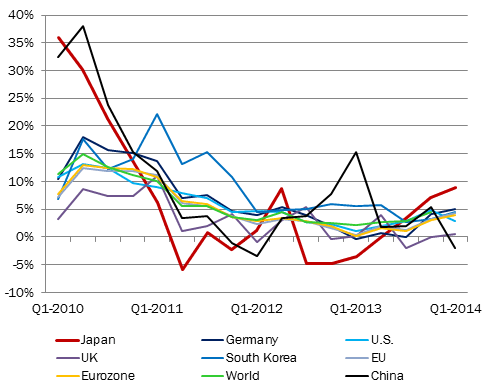
A significant depreciation of the yen is a major factor behind the relatively strong performance of Japan's exports. Figure 2 shows the changes in Japan's export volume by contributing factors, namely, changes in the yen's value, changes in global demand (or global income), and others. We can see that the changes in the yen's value (depreciation) have had a significant impact from 2013 onward.
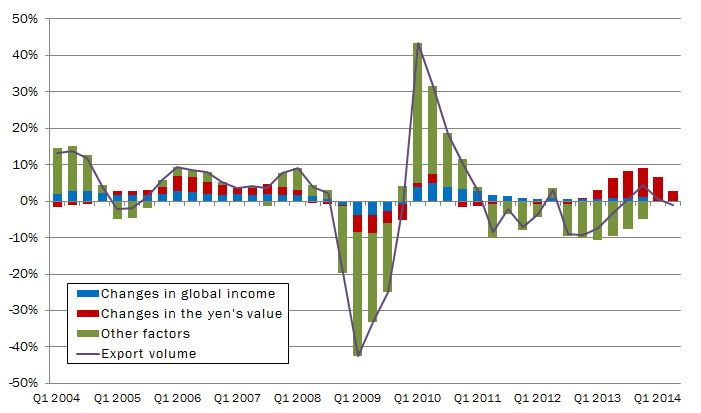
Furthermore, the degree of the manifestation of weak yen effects is the largest in the period from 2000 onward. This means that the yen's depreciation has been giving a significant boost to Japan's exports by lowering foreign currency-denominated export prices, contrary to the widely-held perception that there has been little impact despite a substantial weakening of the yen.
However, it is true that growth in exports has been rather small relative to the size of weak yen effects. From Figure 2, we can see that the near absence of effects of changes in global income is one major factor behind this. The positive effects of a weaker yen have been largely offset by the negative effects of weak growth in the world economy and subdued global trade.
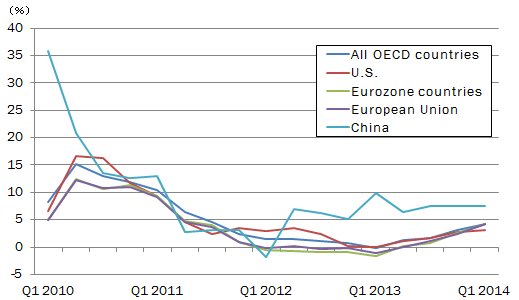
Economic trends in major economies are also convincing about this point. In the United States, the unusually cold weather in early 2014 has had a larger-than-expected impact and the U.S. gross domestic product (GDP) posted the greatest negative growth since shortly after the collapse of Lehman Brothers. The eurozone has been suffering from stagnation with economic growth kept below 1%, and China saw somewhat slower growth in the January-March quarter of 2014. Accordingly, the import volume of each of those economies has increased very little (see Figure 3).
Fortunately, the situation is changing for the better, and we can now expect stronger growth in Japan's exports as the effect of higher global income kicks in on top of that of a weaker yen. The U.S. economy has made a strong recovery, China's economy paced up to post 7.5% growth in the April-June quarter of 2014, and, albeit at a very moderate pace, the eurozone economy is recovering as well. As such, the global economy as a whole is gradually building up steam for growth.
Drastic measures needed to enhance Japan's power to export
Although the recovery of the global economy is a positive factor for Japan's exports, there still remains a major challenge. It is reflected in "Other factors" in Figure 2, a major negative contributor in the past few years. This includes the effects of Japanese manufacturers' loss of competitive advantage and the hollowing out of industries, which proceeded in the post-Lehman period when the yen appreciated sharply.
Indeed, export volume fell sharply, particularly for the automobile industry which is Japan's top exporting industry, in the post-Lehman period and has not recovered much even after the yen's decline (see Figure 4).
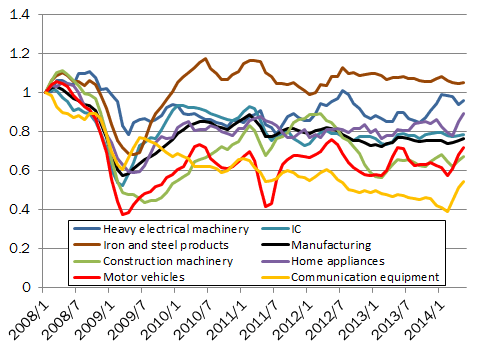
The lack of recovery in the export volume of the automobile industry, which is showing robust performance, reflects the fact that Japanese automakers have already established overseas manufacturing bases to supply for overseas markets, a situation in which a weaker yen would not translate into an increase in exports from Japan. Meanwhile, the primary reason why the home appliances industry and the communication equipment industry, such as mobile phone manufacturers, have been unable to recover is that they have lost customers to their overseas competitors in the high-yen period through 2012.
Even though the yen has weakened significantly, the effects of such manufacturing offshoring and the loss of competitiveness in international markets cannot be reversed readily. In order to increase exports, it is necessary to make continuous efforts to improve the domestic business environment surrounding Japanese exporters, and the government needs to mobilize all possible measures to help enhance Japan's industrial competitiveness.
These include offering a regulatory and taxation environment that is comparable to that of other advanced economies. In this regard, lowering corporate income tax rates and taming soaring energy prices, for instance, by resuming nuclear plant operations, would have a positive impact.
Also, it is indispensable to maintain foreign exchange rate stability as large fluctuations in the yen's value do not contribute to exports. For instance, take the case of Germany, where exports support stable economic growth. Being a part of the Eurozone and hence free from the problem of currency fluctuations within the region is a major advantage. In addition, the relative stability of the euro has been a big contributing factor for Germany's exports to countries outside the Eurozone.
Figure 5 shows the changes in the value of the Japanese and German currencies against the U.S. dollar since 1990. Although the Deutsche mark was replaced by the euro in January 1999, fluctuations in their value against the U.S. dollar throughout the period from 1990 to date have remained within a range of 30% below and above the 1990 level. In contrast, the Japanese yen has generally followed an upward trend, reaching a level of 90% above that of the 1990 level at the peak. Even today, the yen to dollar rate relative to the 1990 level is 25% higher than the euro to dollar rate relative to the 1990 level.
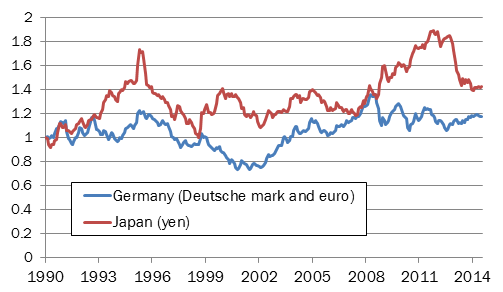
Furthermore, it is necessary to focus efforts on promoting exports by small and medium-sized enterprises (SMEs) that are competitive but have not ventured into overseas markets. Only 2.8% of Japanese SMEs export their products overseas compared to 19.2% of their German counterparts, according to the White Paper on International Economy and Trade 2012.
Although Japan's exports are recovering owing to the effect of a weaker yen, there is a long way to go before turning it into a full-fledged recovery. However, being among the lowest ranked in the world in the ratio of exports to GDP, Japan has plenty of room to increase its exports.
The government has just released its latest growth strategy which calls for revitalizing the Japanese economy by enhancing the vitality of companies. The degree of recovery of Japanese exports is a major barometer of economic revitalization.
* Translated by RIETI.
July 30, 2014 WEDGE Infinity website


